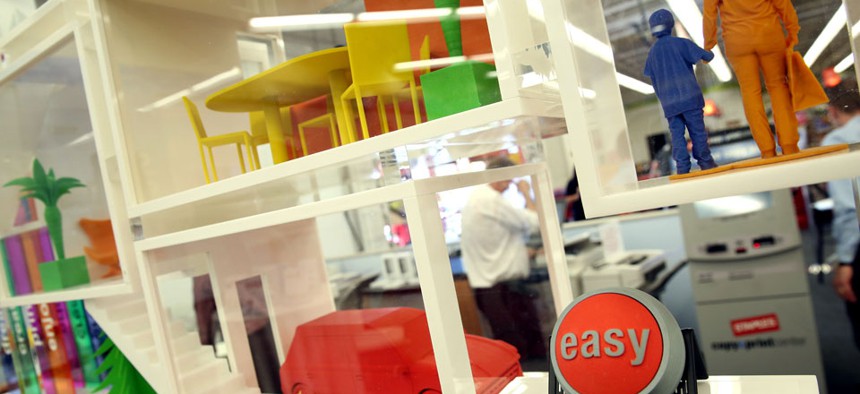The USPS' Hail-Mary Idea: Embrace 3-D Printing

A 3D printing module on display at Staples. The Postal Service's use of 3D printing might not be such an easy fix. Matt Sayles/AP File Photo
Even if the USPS were agile enough to adapt to 3-D printing, doing so would only scratch the surface of remedying the agency's financial troubles.
Earlier this week, Amazon announced that it would begin to sell and ship out customizable, 3-D-printed products—some of which are in truth just slightly customizable, and most of which are fairly costly. The appeal of what seems to be the initiative’s flagship product—a $30, made-to-order bobblehead that can take 10 days to reach your doorstep—stems primarily from the fact that it came from a 3-D printer. But that meager appeal seems spurious, as these products will be manufactured out of view of consumers.
But even if there are impractical aspects ($30? 10 days?) of Amazon’s new enterprise, they're likely to be ironed out in time, and it's clear that the retail behemoth’s adoption of the 3-D-printing model represents another step toward shorter shipping times: If companies can print products quickly at shipping centers, they don't need much of an inventory, and they can ship them out to nearby consumers right away. Amazon is just the most recent in a long line of businesses to angle itself toward this predicted future of manufacturing—a line long enough to include, it turns out, even old-school institutions like the United States Postal Service.
Does the USPS stand to gain from 3-D printing? That's the question the agency sought to answer in a report it commissioned, published earlier this month, that explored the effects of 3-D printing on the distribution of physical packages. The highly speculative report is peppered with coulds: 3-D printing “could have major implications for everyone along existing supply chains”; it “could lead to more single-item parcels being shipped to consumers over shorter distances.” But the report’s central could is this: “The Postal Service could benefit tremendously from the rise of 3-D printing.”
The logic makes sense, at least in the vacuum of the report. 3-D printing, the report predicts, will either be done mainly in people’s homes or at nearby printing centers. The plausibility of the first scenario is (wisely) ruled out, given the high fixed costs of buying a printer and stocking up on a variety of materials; the vision of people printing objects at home might be realized, but it probably won't be as common as most people think. But the prediction that products will be printed close to where consumers live sounds reasonable—UPS has already rolled out 3-D printers at some of its stores.
So if all these custom-made products are being manufactured a couple of miles from consumers’ homes, how do they ultimately arrive on their doorsteps? The USPS, whose network currently includes 153 million addresses in the U.S., covers a ton of ground. It reasons that it could be the one to ferry all those bobbleheads from the printing center to people’s homes. The report projects that this increased package volume would produce about $500 million in new revenue each year—an amount of money that the ailing agency is in no position to sneeze at.
The report has some other ideas, too. Maybe 3-D printing companies seeking competitive delivery speeds will choose to set up shop near existing USPS shipping nodes. Maybe those companies would be interested in occupying some of the more than 60 million square feet of unused floor space the USPS has, much of it in its processing centers. The report labels these opportunities “win-win,” but since we’re talking about the USPS, the formulation is probably more like “win-not-lose-millions-of-dollars.”
It’s hard to say where exactly on the spectrum of “Wouldn’t it be awesome?” to “Let’s do this” this report falls. The French postal service La Poste partnered with the 3-D printing service Sculpteo last fall, and claims the partnership has increased foot traffic at its offices. That said, some of the USPS’s dreams—like creating a “trusted online marketplace for transmission of designs” that’s impervious to copyright infringement—sound too hopeful coming from the agency that got blindsided by email.
Matthew Hersch, a professor at the University of Pennsylvania, says that the USPS actually has a history of conforming to a changing nation. “Improvements like Rural Free Delivery and Parcel Post,” he said in an email, “enabled it to serve more disparate users and carry more diverse materials.”
But those adaptations, Hersch points out, played to the agency’s fortes. “When it comes to new electronic technologies, the Postal Service has struggled. Experiments with online bill-paying over a decade ago were unsuccessful, and the rise of email reduced the volume of personal and business mail,” he said. Given that, Hersch has a hard time seeing how the USPS could capitalize on a technology that’s changing so quickly.
Even if the USPS could act nimbly enough to take advantage of this technology, it’s probably the case that the additional revenue wouldn’t be a cure-all. A postfrom the Brookings Institution broke down the numbers, noting that the agency lost nearly $5 billion last year. Even the most generous revenue projections under the report’s most unlikely scenario, Brookings points out, would only cover about a third of its annual losses.
Near the end of the report’s introductory section, its authors muse, “Who will win from a 3-D printing revolution and who will lose? By embracing this groundbreaking technology, the Postal Service could put a compelling 21st century twist on its historical mission to serve citizens and facilitate commerce.” Could, yes, but probably won’t.





